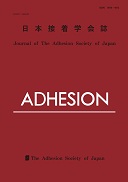All issues

Volume 48, Issue 3
Displaying 1-4 of 4 articles from this issue
- |<
- <
- 1
- >
- >|
Short Communication
-
Hideki HAYASHI, Takeshi YAMADA, Akio KITOH, Yoshitaka MIZUTANI, Michin ...2012Volume 48Issue 3 Pages 103-108
Published: March 01, 2012
Released on J-STAGE: June 30, 2014
JOURNAL FREE ACCESSAlthough micro-Raman spectroscopy is a useful method as a strain probe with high spatial resolution, it produced relatively limited results for some Raman inactive materials, such as metals. In this study, acetylene-containing polyurethanes were prepared for strain-sensing materials. Solutions of the polymers were coated onto an Al wire, and then Raman spectra from the coated polymers were measured simultaneously during stretching. As the results, the Raman frequency of C=C stretching mode of the coated polymer shifted at a rate of about -2cm-1/%. In the past, for cross-linking of cast film, diacetylene-containing prepolymers were heated to prepare strain-sensing materials, but the present polymers do not have the necessity of heating. So, an usage of these polymers not only simplifies the process but also makes to spread a material application field.View full abstractDownload PDF (1875K)
Original Paper
-
Osamu SHIMOMURA, Yosuke ISHINO, Takeshi IMADA, Atsushi OHTAKA, Ryoki N ...2012Volume 48Issue 3 Pages 97-102
Published: March 01, 2012
Released on J-STAGE: June 30, 2014
JOURNAL FREE ACCESSCopolymerization of styrene with 2.5 mol% of bis(4-vinylbenzyl)disulfide (1) under radical suspension polymerization conditions gave an insoluble cross-linked polystyrene (2) in 72% yield. Polystyrene 2 was treated with tributylphosphine (TBP) and water in THF to give soluble copolymer 3 possessing free thiol groups,which were successively protected by acetylation to give soluble copolymer (4). To regenerate an insoluble cross-linked polystyrene, the thiol groups were deprotected by NaBH4 and the generated thiols were oxidized to disulfide again by iodine to obtain the insoluble polymer with spherical shapes.View full abstractDownload PDF (2124K)
Comprehensive Paper
-
Tetsuo YAMAGUCHI2012Volume 48Issue 3 Pages 83-89
Published: March 01, 2012
Released on J-STAGE: June 30, 2014
JOURNAL FREE ACCESSWhen soft viscoelastic materials are detached from or slid against a hard substrate, complex defor mation behavior such as cavitation, fibrillation, and Schallamach waves is often observed in such materials. This behavior is important not only in terms of science but also in a practical or industrial sense. In this paper, we introduce our studies on adhesion and friction of pressure-sensitive adhesives and polymer gels.View full abstractDownload PDF (2467K)
Original Paper
-
Masatsugu MURASE2012Volume 48Issue 3 Pages 90-96
Published: March 01, 2012
Released on J-STAGE: June 30, 2014
JOURNAL FREE ACCESSThe adhesion durability of the polyethylene coated steel which used as the base material the steel which added Cr 0-9% and SUS410, 430, 304 was investigated in immersion test and a neutral salt spray test (SST). The adhesion durability after 0.5M NaCl immersion at 60℃ improves as the amount of Cr increases. Although the delamination kinetics of the coating layer from the edge after a SST is also improved according to the increase in the amount of Cr, but this effect is saturated above 9% addition. It was suggested that it is related to the corrosion potential of bare steel that adhesion durability improves with the increase in the amount of Cr. It is thought that corrosion potential is shifted to noble by adding Cr is making small electrode potential difference between the steel surface under coating layer and bare steel area, and is considered to inhibit the cathode reaction under coating layer. However, the stainless steel must take into consideration that the influence of the crevice corrosion under coating delamination and adhesion loss area and SUS304 are inferior in adhesiveness.View full abstractDownload PDF (2477K)
- |<
- <
- 1
- >
- >|